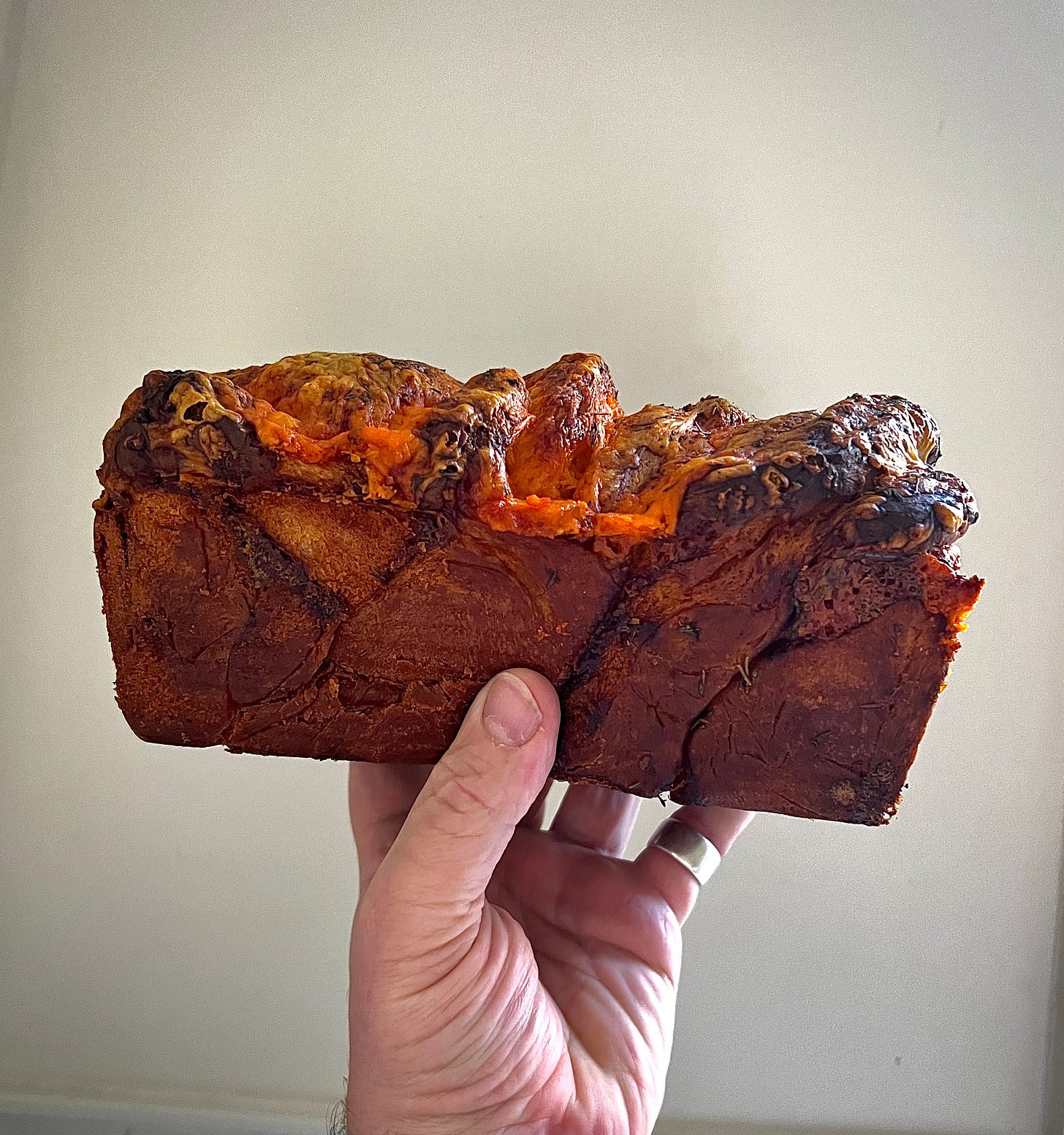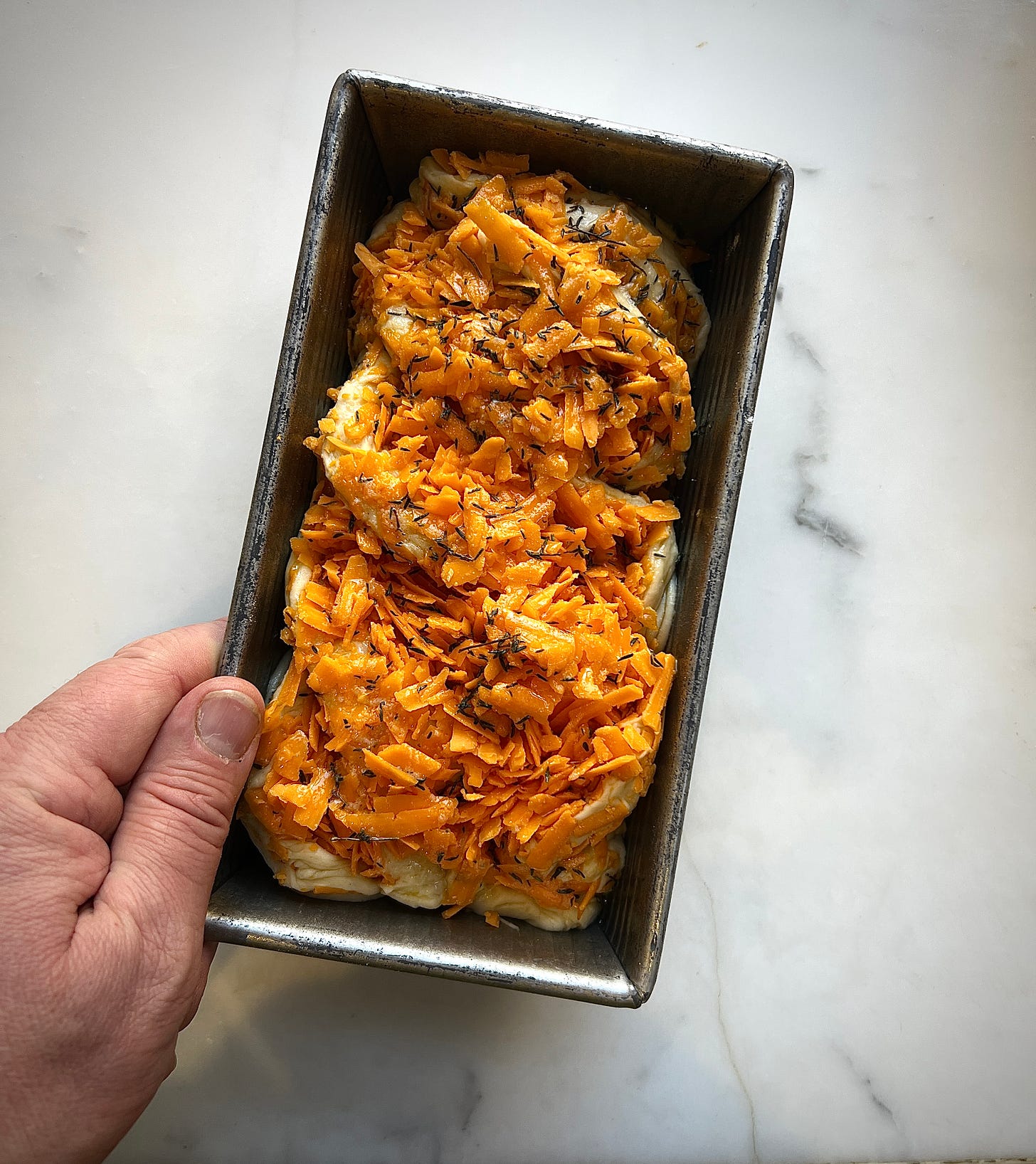As promised, a recipe for a loaf of cheese bread
Oozing with Double Gloucester, garlic butter and thyme.
Bombarding you with emails today.
As I promised last week, here is a short piece for you that shares my recipe for a magnificent enriched loaf of cheese bread. Not particularly challenging, as long as you’re comfortable baking bread, and then even if you’re not, you should probably set yourself to the task anyway. There is little to confound you here. A simple dough, left to rise, flattened and sprinkled with a lot of cheese, rolled, cut, twisted and baked.
It might even be that it causes you to weep just a little, when you eat that first slice while it is warm. It is delicious. Invariably it is best never to cut loaves open whilst they are warm, as it affects the crumb as they cool making the structure gummy. Here however I excuse myself.
It oozes cheese.
It is a revelation.
With a little butter spread on the slice and if like me you like a little crunchy salt, then jump in. I will add that it’s probably for the better not to put it in the toaster as you’ll likely set fire to your kitchen.
(After witnessing the destruction of one toaster yesterday, by a street cat named Moon from Los Angeles who lives here on the farm, rescued from Beverley Hills, flown across the Atlantic with her kittens for a better life; a beautiful, wise but needy feline, and one that has a penchant for peeing in random objects, often electrical ensuring that fuses are tripped, plug sockets destroyed, fizzing with sparks and upsetting the dogs, the Alexa was a victim, alongside kettles, important paperwork and tote bags, and as said yesterday afternoon the toaster).
Best put the slice under the grill if you are so minded.
A loaf of Double Gloucester cheese bread
A ‘Gloucester’ is a cheese that hails from the city of the same name in the Cotswolds of England for what is likely the last five hundred or so years, its deep orange colour traditionally comes from the addition of the flower Lady’s Bedstraw. Single or Double, no one really knows why, though there are many theories. Made from the milk of Gloucester cows up until the late 1950s the cows nearly became a lost breed until a handful were gathered and their milk put into production again. This cheese is now made by only a handful of dairies, and to maintain its protected status must come from the county of Gloucestershire and come from the milk of Gloucester cattle.
It is also the cheese that is hurled down a steep Cotswold hillside with a fifty per cent gradient every year in spring, in a sport peculiar to the English known as Cheese rolling. The wheel of cheese is pursued by a gathering of the mad, who also hurl themselves down the very same steep grass hill to chase after it. Legs are broken, ankles twisted and much cider is consumed. The prize is the small wheel of cheese and the honour.
My recipe
You will need
100 ml buttermilk
100ml hand warm water
25g sugar
1 sachet of dry yeast
1 large egg
1 tsp onion powder
1/2tsp garlic powder
1/2 tsp dried thyme
1 tsp sea salt
75 g melted butter plus a little more for brushing before baking
400g strong bread flour
250 g Double Gloucester cheese- you can use cheddar but the colour will not be the same.
How to
Warm the buttermilk gently so it is barely warm and add the water to a large bowl
Stir in the yeast and sugar and leave it to sit. After about ten minutes you should see that the yeast will begin to bubble.
Melt the butter, not too hot, and add to the yeasty mixture and then beat in the egg.
Take around one-third of the flour, beat into the mixture and whisk till smooth
Now add the rest of the flour, salt, garlic and onion powder and bring together to a sticky ball. It will be a little sticky but this is correct.
Knead the dough with flour on a bench for 10 minutes. Be quite vigorous.
Now place the silky ball of dough into a greased bowl and cover with a towel. Place it in a warm spot and leave it to rise till it doubles in size. This might take an hour or two. Be sure to let it double.
Now turn it out onto a floured table, and roll it out in a rectangle, approximately 20cm x 40cm
Cover the surface of the dough with the cheese, leaving a strip of about 2 cm at the long edge furthest away from you. This is the seam that will hold it together when you roll it.
Now roll it up into a tight long sausage shape, and next is the interesting part.
Be not deterred.
Cut with a large sharp knife along its length, exposing the cheese layers, so the sausage is now in two long sections with the cut layers of cheese facing up at you (yes I know this is weird) then cross one piece over the other, twisting it together like a short braid. The cheese should be exposed through the twist. Tuck the ends in and place it in a greased loaf tin.
Bake at 180c fan on the middle shelf of the oven for about 45 mins
It should have risen well, be a deep golden colour and will be gloriously covered in the abundance of melted cheese from the layers that you cut open as you shaped it. If you have twisted well, then through out the loaf will be pockets of warm cheese.
Now as it cools, brush with a little melted butter and sprinkle with thyme.
If indeed you can wait, then you must have more patience than me. Enjoy in thick slices spread with butter. It will last a day or two before becoming stale, though I doubt it will last that long as you’ll most likely eat it.
Until tomorrow
William







Oh. My. Goodness.
The bread sounds divine, and the cat is clearly a show stealer. I’d love to catch glimpses of her sneaking through the pages of your next cookbook and causing mischief.